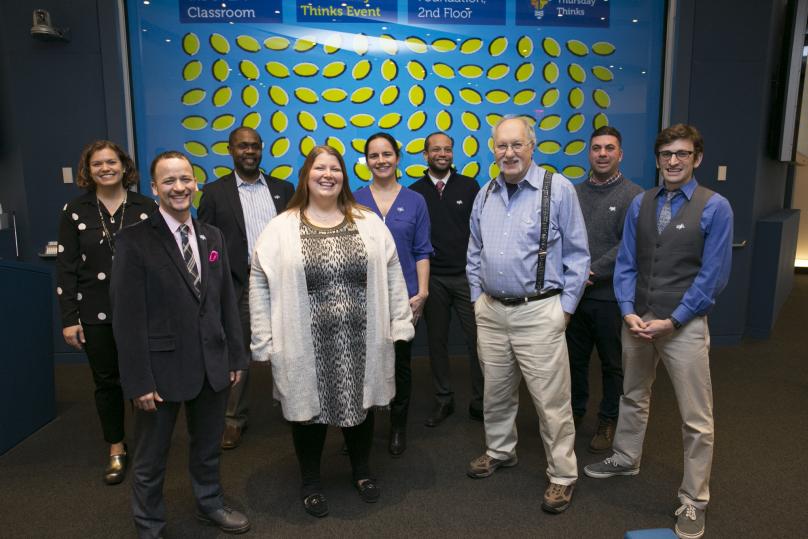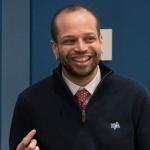
By Seth Guiñals-Kupperman, MƒA Master Teacher
The theme of this year’s MT²: Master Teachers on Teaching was “Truth Matters: Logic, Lies and Trust in the STEM classroom,” and you don’t have to be a news junkie to understand why that’s so relevant right now.
MT² is not just an event with “talks that make you think,” but a night where teachers who have put a great deal of thought – and passion and energy and time – into reflecting on their practice arrive at a truth they are so struck by, they must share.
For each one of the MƒA Master Teacher presenters, their “Eureka” moment was different, and they entered the theme of the evening from a different angle. Some shared the critical role trust plays in the classroom, both when it is needed and what happens in its absence. Some showed the power of logical thinking to truly harness the power of medicine… or turn your back on it. And all shared deep and profound truths about teaching, about students, or about the world that we were richer for hearing. MT² showcases MƒA Master Teachers who think deeply, share selflessly, and describe vividly the practice of STEM teaching. It was truly an evening to experience!
I was inspired to share my “Just One Thing” address by my mother and father, both passionate and lifelong educators in the New York City public schools. They both modeled for me that teaching as a career is a marathon, not a sprint. The transformation I’ve undergone since my time as a novice is thanks to persistent small changes, and reflection. This wisdom is what I hoped to share with the community.
Molly Shabica, a brilliant and reflective Physics teacher at Fannie Lou Hamer Freedom High School, served as the evening’s Emcee. Molly is a veteran of MT², having both presented and written about it for the Teacher Voices blog. Having fully recovered from the events immediately preceding the previous MT², Molly returned to the stage with a fighting spirit, renewing our conviction that in uncertain times, the truth cannot be silenced, nor can it be denied.
Bruce Greenspan, a Physics teacher, began with a story about a loss of innocence: when his scientific idol – his biology teacher dad, an unwavering skeptic – revealed himself to be a consumer of quackery and snake oil. Bruce reminded us what is at stake if we do not teach our students the power of logical and skeptical thinking. Bruce storied how discovering his father’s flaws inspired him to develop an innovative learning experience for his students. And by helping his students think skeptically, he is inoculating them against bunk.
Gardy Alabre, a Mathematics teacher, challenged the conventional wisdom: calculus must come last. Through a combination of research and personal experience, Gardy made the case that the ideas of calculus should not be all held off until the end of high school. The truth, according to Gardy, the research, his own and his students’ experiences is your students can handle the challenge. They are ready to begin learning some of the fundamental conceptual ideas of calculus. But to see it, you must question your own assumptions about what they’re “ready” to learn.
Peter Brooks, a Computer Science teacher, teaches a course of his own design called “Human Reasoning.” Peter’s story was at once personal, rational, deeply emotional, and educational. Peter reminded the audience that most people (physicians too, unfortunately) don’t have a fundamental understanding of statistics. When he and his wife first received test results about a cancer, their minds were awash in emotions completely clouding their abilities to think logically. Peter shared that by using mathematical tools over 200 years old, he was able to put into perspective his wife’s prognosis and fundamentally change his and his wife’s outlook on the future. Make no mistake: mathematics doesn’t just save lives; it also saves sanity.
Kit Golan, a Mathematics teacher, realized a truth many teachers selectively ignore: that our students crave a connection with their teachers as professionals AND as people. Kit’s key realization was that when students ask personal questions, it doesn’t have to be a distraction, but can be an exciting hook for a lesson. Kit found that he could leverage his students’ natural curiosity about him to teach mathematics by making himself and his own life the centerpiece of the problem.
Some lessons come at a high price. Earth Science teacher Patrick Callahan’s truth in the STEM classroom was learned through the pain of fracturing his leg while hiking with a group of highly motivated, engaged science students during a summer enrichment field experience. Patrick learned firsthand what is at stake when your students have the abilities, but do not function as a community who care for one another.
What distinguishes Tamara Park’s classroom, where she teaches Biology, from others is one word: choice. Tamara recalls being empowered in high school when her guidance counselor gave her the choice to remain and be a precocious rebel, or go to college early, where she would flourish. Tamara valued the choice she was given so greatly that she infuses student choice in her classroom into projects, assignments, and assessments. Tamara is helping her students find the balance between a singular pathway to be followed and blazing a trail without a compass.
Nancy Buck’s first real math teacher was her father, who would help her with homework by “being annoying,” which meant talking to her not as a child, but as a peer mathematician. He was trying to show her the truth about how math is done by showing her how mathematicians do math. This dynamic requires risk, trust, and communication. Nancy found that when she established those conditions in her seventh-grade mathematics class, she was able to paint for her students the honest picture of mathematics her father showed her: that it is joyful, creative, intuitive, challenging, and rewarding.
Each of the speakers came to a deep truth about teaching or their subject through different paths. Each is now able to do something in their classroom that they could not before because they took a risk to try something new. What captivated the audience was their passion and success; what inspired the audience was the message that each one of us can achieve what they did, too. At MT² teachers don’t share what they realized in order to brag – they share to inspire us all to take a risk, and in this year’s event, open their students' eyes to some of the deep truths about science, mathematics, and the world.
MT² is an opportunity to share, learn, and be inspired by the success of others. But presenting doesn’t need to be the end of their story: it could be the beginning of yours.
